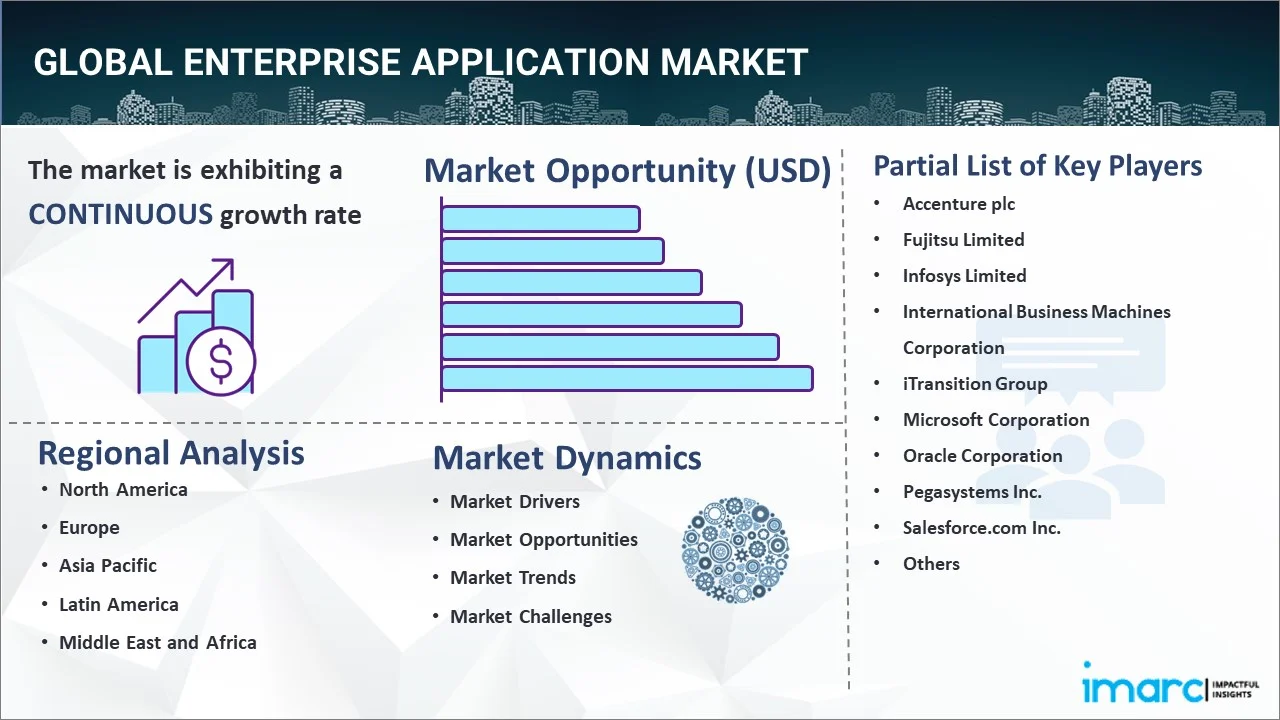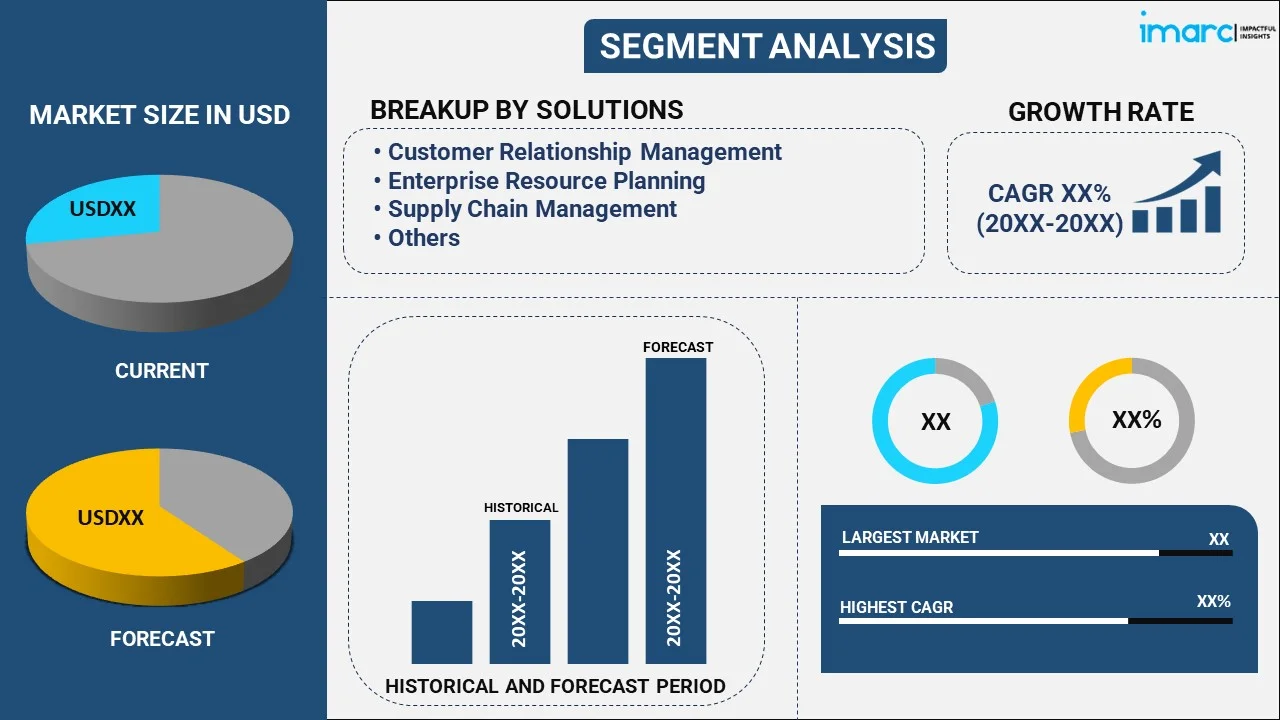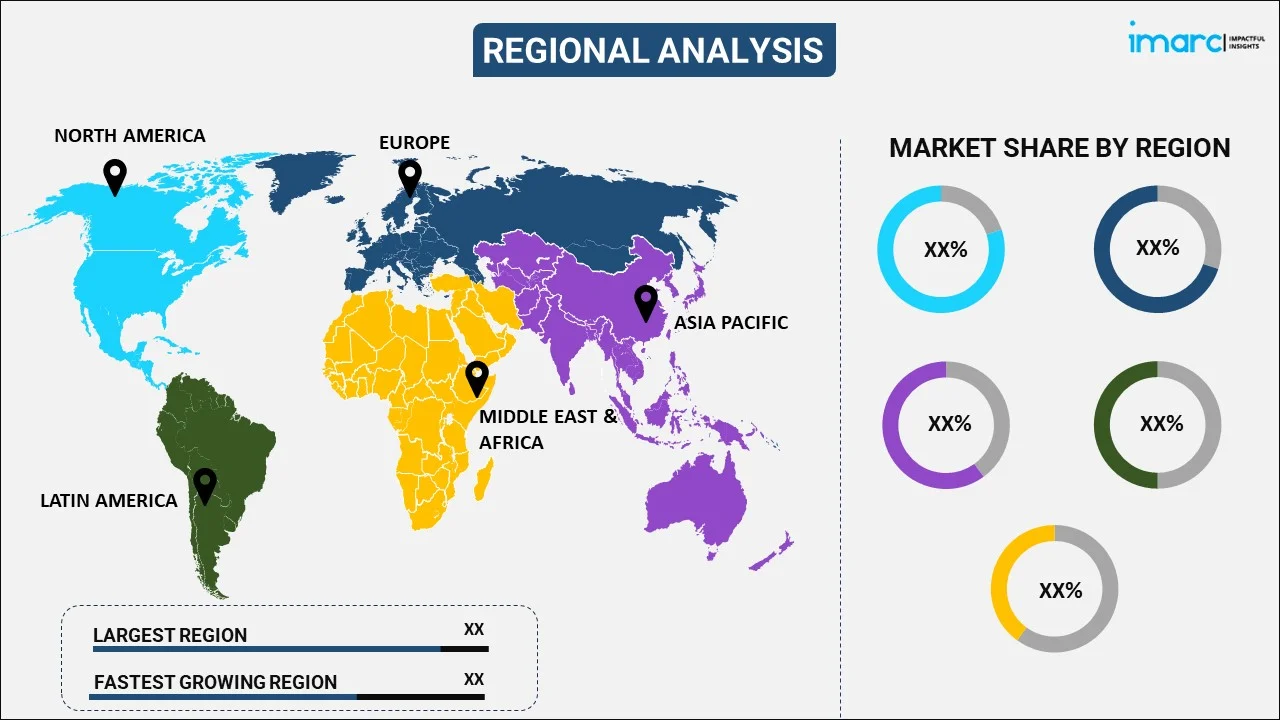
Enterprise Application Market Report by Solution (Customer Relationship Management, Enterprise Resource Planning, Supply Chain Management, Analytics and Business Intelligence, Human Capital Management, Productivity Tools, and Others), Organization Size (Small and Medium Enterprises, Large Enterprises), Deployment Mode (On-premises, Cloud-based), End User (BFSI, Manufacturing and Retail, Healthcare and Pharmaceuticals, IT and Telecommunication, Government, and Others), and Region 2025-2033
Market Overview 2025-2033:
The global enterprise application market size reached USD 314.9 Billion in 2024. Looking forward, IMARC Group expects the market to reach USD 571.2 Billion by 2033, exhibiting a growth rate (CAGR) of 6.5% during 2025-2033. The market is witnessing significant growth mainly driven by the increasing demand for digital transformation, AI integration, and cloud adoption. Currently, North America holds the largest market share, fueled by advanced technological infrastructure, substantial investments in enterprise solutions and supportive government initiatives promoting innovation and business growth across industries.
|
Report Attribute
|
Key Statistics
|
|---|---|
|
Base Year
|
2024 |
|
Forecast Years
|
2025-2033
|
|
Historical Years
|
2019-2024
|
| Market Size in 2024 | USD 314.9 Billion |
| Market Forecast in 2033 | USD 571.2 Billion |
| Market Growth Rate (2025-2033) | 6.5% |
Enterprise applications include digital and content creation, communication and collaboration software, customer relationship management (CRM), and enterprise resource planning (ERP). They are scalable, component-based, data-centric, and user-friendly. They are used to integrate core business processes, such as sales, finance, accounting, inventory, human resources, and manufacturing, on a single server architecture in real-time. They provide the advantages of office suites, project and portfolio management, and supply chain management (SCM). Consequently, they are deployed in corporate networks to automate business processes with large amounts of complex data and connect enterprises with suppliers, commercial entities, and customers across the globe.

Enterprise Application Market Trends:
Increase in Cloud Adoption
Cloud adoption is transforming the enterprise application landscape by offering unmatched flexibility and scalability. Businesses are increasingly migrating to cloud-based solutions to easily adjust resources based on the demand, ensuring cost-efficiency by eliminating the need for hefty upfront investments in IT infrastructure. For instance, in July 2024, Infosys announced a five-year collaboration with Sector Alarm, a leading security provider in Europe, to migrate their enterprise business systems to the cloud. Infosys will work closely with Sector Alarm to move their on-premises Enterprise Resource Planning platform to Microsoft Dynamics 365 Finance and Operations. This shift not only reduces maintenance and operational costs but also enhances agility, allowing organizations to quickly respond to market changes. Cloud platforms provide seamless access to applications from any location, which supports remote work and fosters collaboration among distributed teams. According to enterprise application market forecast, cloud adoption will remain a pivotal factor driving market evolution as businesses continue to prioritize digital transformation and resilient infrastructure. Additionally, features like automatic updates, robust security measures, and advanced integration capabilities make cloud-based applications a preferred choice for enterprises aiming to innovate and stay competitive.
Integration of AI and Automation
The integration of AI and automation into modern enterprise applications revolutionizes business operations by enhancing efficiency and decision-making. AI-driven features, such as predictive analytics, natural language processing (NLP), and machine learning (ML), enable applications to analyze vast amounts of data, identify patterns, and generate actionable insights. Automation streamlines repetitive tasks, reduces human error, and accelerates workflows, allowing employees to focus on strategic activities. These enterprise application market trends are driving significant innovation, enabling organizations to boost productivity, enhance customer experiences, and maintain a competitive edge in a rapidly evolving digital landscape. For instance, in March 2024, SAP and NVIDIA announced their partnership to bring generative AI to enterprise cloud solutions, aiming to provide custom AI capabilities for businesses. The collaboration will integrate generative AI into SAP's cloud solutions and applications, leveraging NVIDIA's AI foundry service and microservices. The partnership seeks to accelerate AI adoption across organizations and enhance customer insights through innovative use cases. This synergy not only boosts productivity and operational efficiency but also fosters innovation and agility, helping enterprises stay competitive in a rapidly evolving market.
IoT Integration
IoT Integration is revolutionizing enterprise applications by connecting a vast network of devices that generate valuable data. In manufacturing, for instance, IoT-enabled systems monitor machinery in real-time, predicting maintenance needs and reducing downtime. In healthcare, connected devices track patient vitals continuously, enhancing patient care and operational efficiency. Logistics companies use IoT applications to monitor shipments, optimize routes, and manage inventory with precision. By collecting and analyzing data from these connected devices, enterprises gain actionable insights that drive informed decision-making and streamline processes. For instance, in August 2024, Oracle integrated AT&T IoT connectivity and network API's into its Enterprise Communications Platform (ECP) to provide reliable, secure communications. This integration supports Oracle industry cloud applications, offering real-time connectivity for IoT devices on the AT&T network. The collaboration also includes FirstNet®, Built with AT&T, which serves as the foundation for Oracle's Public Safety Suite, enabling secure communications for critical components such as dispatch command centers and real-time camera feeds for first responders. This integration not only boosts productivity and reduces costs but also fosters innovation, enabling businesses to respond swiftly to market changes and customer demands across various industries. These enterprise application market trends are creating positive outlook for the market further across the world.
Key Market Segmentation:
IMARC Group provides an analysis of the key trends in each sub-segment of the global enterprise application market report, along with forecasts at the global, regional and country level from 2025-2033. Our report has categorized the market based on solution, organization size, deployment mode and end user.
Breakup by Solution:

- Customer Relationship Management
- Enterprise Resource Planning
- Supply Chain Management
- Analytics and Business Intelligence
- Human Capital Management
- Productivity Tools
- Others
Breakup by Organization Size:
- Small and Medium Enterprises
- Large Enterprises
Breakup by Deployment Mode:
- On-premises
- Cloud-based
Breakup by End User:
- BFSI
- Manufacturing and Retail
- Healthcare and Pharmaceuticals
- IT and Telecommunication
- Government
- Others
Breakup by Region:

- North America
- United States
- Canada
- Asia-Pacific
- China
- Japan
- India
- South Korea
- Australia
- Indonesia
- Others
- Europe
- Germany
- France
- United Kingdom
- Italy
- Spain
- Russia
- Others
- Latin America
- Brazil
- Mexico
- Others
- Middle East and Africa
Competitive Landscape:
The report has also provided a comprehensive analysis of the competitive landscape in the global enterprise application market. Detailed profiles of all major companies have also been provided. Some of the companies covered include:
- Accenture plc
- Fujitsu Limited
- Infosys Limited
- International Business Machines Corporation
- iTransition Group
- Microsoft Corporation
- Oracle Corporation
- Pegasystems Inc.
- Salesforce.com Inc.
- SAP SE
- Software AG
- Tata Consultancy Services Limited
Kindly note that this only represents a partial list of companies, and the complete list has been provided in the report.
Enterprise Application Market News:
- In March 2024, Zones and Sonata Software announced their partnership to simplify enterprise application delivery through end-to-end cloud-managed services. The five-year agreement aims to provide cost efficiency and data optimization through joint offerings and industry-specific solutions. This collaboration will enable customers to modernize their technology footprint and leverage the benefits of cloud migration.
- In June 2023, DXC Technology announced its partnership with Oracle to provide new application services powered by Oracle Cloud Infrastructure (OCI). This partnership will help DXC deliver transformation solutions faster and cheaper, ultimately benefiting their customers. The expanded collaboration aims to deliver new application solutions and innovations powered by OCI, enabling customers to achieve their transformation objectives.
Report Coverage:
| Report Features | Details |
|---|---|
| Base Year of the Analysis | 2024 |
| Historical Period | 2019-2024 |
| Forecast Period | 2025-2033 |
| Units | Billion USD |
| Segment Coverage | Solution, Organization Size, Deployment Mode, End User, Region |
| Region Covered | Asia Pacific, Europe, North America, Latin America, Middle East and Africa |
| Countries Covered | United States, Canada, Germany, France, United Kingdom, Italy, Spain, Russia, China, Japan, India, South Korea, Australia, Indonesia, Brazil, Mexico |
| Companies Covered | Accenture plc, Fujitsu Limited, Infosys Limited, International Business Machines Corporation, iTransition Group, Microsoft Corporation, Oracle Corporation, Pegasystems Inc., Salesforce.com Inc., SAP SE, Software AG, Tata Consultancy Services Limited, etc. |
| Customization Scope | 10% Free Customization |
| Post-Sale Analyst Support | 10-12 Weeks |
| Delivery Format | PDF and Excel through Email (We can also provide the editable version of the report in PPT/Word format on special request) |
Key Questions Answered in This Report:
- How has the global enterprise application market performed so far and how will it perform in the coming years?
- What has been the impact of COVID-19 on the global enterprise application market?
- What are the key regional markets?
- What is the breakup of the market based on the solution?
- What is the breakup of the market based on the organization size?
- What is the breakup of the market based on the deployment mode?
- What is the breakup of the market based on the end user?
- What are the various stages in the value chain of the industry?
- What are the key driving factors and challenges in the industry?
- What is the structure of the global enterprise application market and who are the key players?
- What is the degree of competition in the industry?
Need more help?
- Speak to our experienced analysts for insights on the current market scenarios.
- Include additional segments and countries to customize the report as per your requirement.
- Gain an unparalleled competitive advantage in your domain by understanding how to utilize the report and positively impacting your operations and revenue.
- For further assistance, please connect with our analysts.
 Inquire Before Buying
Inquire Before Buying
 Speak to an Analyst
Speak to an Analyst
 Request Brochure
Request Brochure
 Request Customization
Request Customization




.webp)




.webp)












